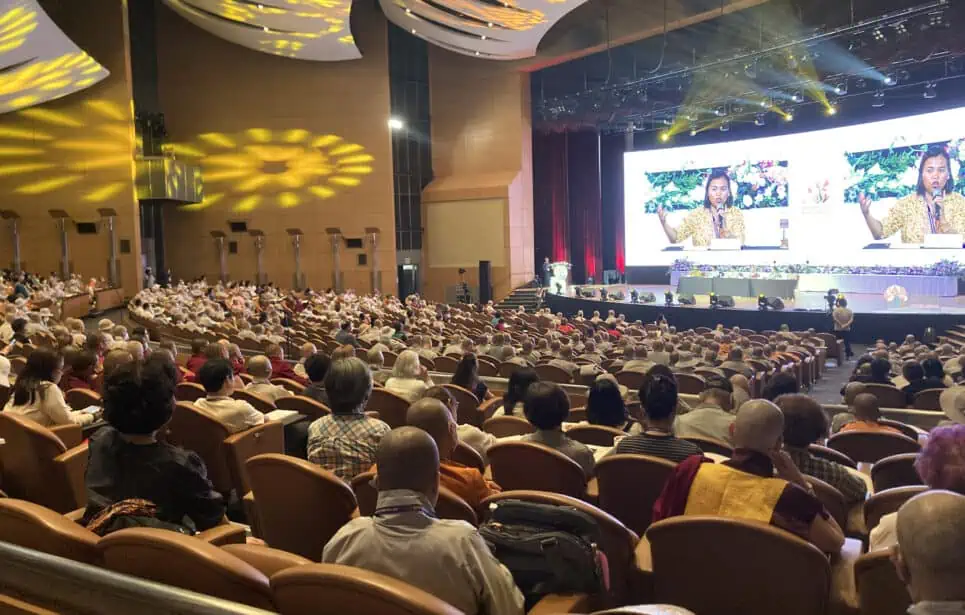The 18th Sakyadhita conference

Venerable Samten reports from the 18th Sakyadhita International Conference in Seoul, South Korea.
The 18th Sakyadhita Conference took place in Seoul, Korea, June 23–27, 2023. I did not expect to be so deeply moved and inspired by the experience; it was powerful. There are many reasons that I can identify and many more that may come to light over time. Being in the company of approximately 3,000 women, mostly nuns, was impactful. To be in the company of women who have committed their lives to full-time Dharma practice in those numbers is a rare experience for a person living in North America. Waiting to cross a busy street and then walking with hundreds of nuns, lay women, and men as we headed to and from the Bongeunsa Temple each and every time was a visual that is unforgettable; flowing robes, smiling faces, palms together when meeting.
The planning and organization of a conference of this size must have taken years, with many teams of people, contributing creative and innovative solutions and so many opportunities to practice fortitude to make the conference a rich and meaningful experience for all. In addition to the conference, our kind hosts offered meals to 3,000 people, twice a day. Wonderful meals were ready, there were no long waits and to ensure that the conference was eco-friendly, meals were served on actual plates and bowls; the dishwashing task must have been huge, but nothing was going into a landfill or recycling depots!
The opening ceremony of the conference included chanting in Pali, Chinese, Tibetan, Vietnamese, and Korean. Beautiful musical offerings by bhikshuni and lay musicians brought a sense of closeness and warmth to everyone in the filled to overflowing auditorium. Congratulatory speeches by many illustrated the joy and heart felt wishes for all in attendance to feel welcome and to rejoice in this rare and precious opportunity. As described on the Sakyadhita website: “Working at the grassroots level, Sakyadhita provides a communications network among Buddhist women internationally. We promote research and publications on Buddhist women’s history and other topics of interest. Our members strive to create equal opportunities for women in all Buddhist traditions. We work to empower the world’s 300 million Buddhist women to work for peace and social justice through local branches, the content we offer free of charge online, and through our biannual conferences.”
The schedule for the five-day conference flowed seamlessly and seemingly without hitches. If there were problems, they were handled in a graceful and careful way that did not come into view. The first full day of the conference, we heard 11 papers that revolved around the topics Buddhist women in Korea, gender stereotypes, and inspiring resilient figures. The topics for the following days included: awakening: women’s ordination past and present; pilgrimage, precarity and practice; and manifestations of Buddhadharma. Each and every presenter must have felt the support, the appreciation, and gratitude expressed when possible for their work in bringing these topics to our attention. I am looking forward to making the time to re-read each paper.
The innovative approach of having Sharon Suh, President of Sakyadhita International, interview Vanessa Sasson, scholar and author of The Gathering; A Story of the First Buddhist Women, made for a delightful and engaging session. Thoughtful and well-crafted questions allowed Vanessa to share her inspiration gained from the Therigatha and its commentary and her process in researching and writing the book. The retelling of the story of the women’s request for ordination shines a light on Vimala, Patachara, Bhadda Kundalakesa, and many others as they walk through the forest to request full access to the tradition from the Buddha. The beautifully written endnotes are just as interesting to read as the main body of the book.
Afternoon workshops were designed for people to gather in smaller groups allowing for interaction and discussions; these sessions were a wonderful way to start conversations and share experiences. Venerable Jampa, who traveled from Germany, joined me in presenting a workshop where we shared how monastics are trained at Sravasti Abbey. Relating the many causes and conditions that led to Venerable Chodron starting a monastery in NE Washington State with the specific purpose to establish the Dharma in the West for generations to come is always an inspiring story to share. We shared the importance and advantages of living in a community and the description of how one enters this monastic community; from being a lay person, training as an anagarika, taking novice ordination and eventually full ordination; a process that is done by women and men.
Providing translation for the workshops was an extremely kind and thoughtful addition to this conference. Ho Sook appeared about five minutes before our session started, glanced at the notes we had prepared, and joyfully dove into the talk, allowing more than half of the people in our workshop, Korean speakers, to understand and fully participate. We were so grateful for your invaluable contribution Ho Sook!
Sakhyadhita, which means Daughters of the Buddha, is the result of the first International Conference of Buddhist Nuns that took place in 1987 in Bodhgaya, India. To quote from the publication that came from that time “Sakydhita Daughters of the Buddha,” edited by Karma Lekshe Tsomo, Bhikshuni Jampa Tseodron wrote:
Many people have asked why this International Conference on Buddhist nuns in Bodhgaya has been attracting so much attention. No doubt one reason is the fact that this gathering is the first conference of Buddhist nuns to have taken place in India sine the time of Buddha Sakyamuni. It is known that the bhiksus came together for several councils after the Buddha passed into final nirvana, but there is no evidence that bhikshunis played a role at any of these councils. Nevertheless, Buddha Sakyamuni taught that all sentient beings have the same potential (Buddha Nature) to obtain enlightenment, and women today have more freedom than ever before to explore and develop this potential.
The opening address of His Holiness the 14th Dalai Lama gave many people reassurance regarding the serious objectives of the conference. Some observers feared that the gathering could be misused as a platform for Western feminists in a blind battle for equal rights that would damage Buddhism. Yet all soon discovered that such fears were unnecessary. The head of the Mahabodhi Temple Management Committee, a highly esteemed monk of the Theravada tradition, stated with pleasure: “Worries that some people had at the beginning of the conference have obviously not been confirmed. The conference took place in a very harmonious and peaceful atmosphere. The nuns can also count on my support.
The far reaching long range benefits of the conference are yet to be seen, but there are already some remarkable indications. Not only did the event have historical importance, it was also a landmark gathering of nuns and laywomen of nearly all traditions, with the support also of many monks and lay men.
Would those who attended the Bodhgaya conference in 1987 have imagined that 36 years later, 3,000 people would come together to continue the work and the support for Buddhist women? Those of us who had the amazing opportunity to attend the conference this year in Korea had the direct rich experience of meeting many practitioners from 31 different countries and many different Buddhist traditions. Words really cannot convey the magnificent experience that I had; the kindness and warmth of our Korean hosts is something that will stay with me.
The 18th Sakyadhita conference was a success on all levels. It is my hope that every single person involved in bringing this to fruition has a well-deserved rest and their hearts are filled with deep happiness from having invested so much virtuous effort. I am profoundly grateful to these people, to Venerable Karma Lekshe Tsomo for her unwavering commitment to Sakyadhita and to my teacher, Bhikshuni Thubten Chodron, for the opportunity to be part of the conference.
Venerable Thubten Samten
Venerable Samten met Venerable Chodron in 1996 when the future Venerable Chonyi took the future Ven. Samten to a Dharma talk at Dharma Friendship Foundation. The talk on the kindness of others and the way it was presented is deeply etched in her mind. Four Cloud Mountain retreats with Ven. Chodron, eight months in India and Nepal studying the Dharma, one month of offering service at Sravasti Abbey, and a two month retreat at Sravasti Abbey in 2008, fueled the fire to ordain. This took place August 26, 2010 (see photos). This was followed by full ordination in Taiwan in March, 2012 (see photos), becoming Sravasti Abbey's sixth bhikshuni. Right after finishing a Bachelor of Music degree, Ven. Samten moved to Edmonton to pursue training as a corporeal mime artist. Five years later, a return to university to obtain Bachelor of Education degree opened the door to teaching for the Edmonton Public School board as a music teacher. Concurrently, Ven. Samten became a founding member and performer with Kita No Taiko, Alberta's first Japanese drum group. Ven. Samten is responsible for thanking donors who make offerings online; assisting Venerable Tarpa with developing and facilitating the SAFE online learning courses; assisting with the forest thinning project; tracking down knapweed; maintaining the Abbey database and answering email questions; and photographing the amazing moments that are constantly happening at the Abbey.


